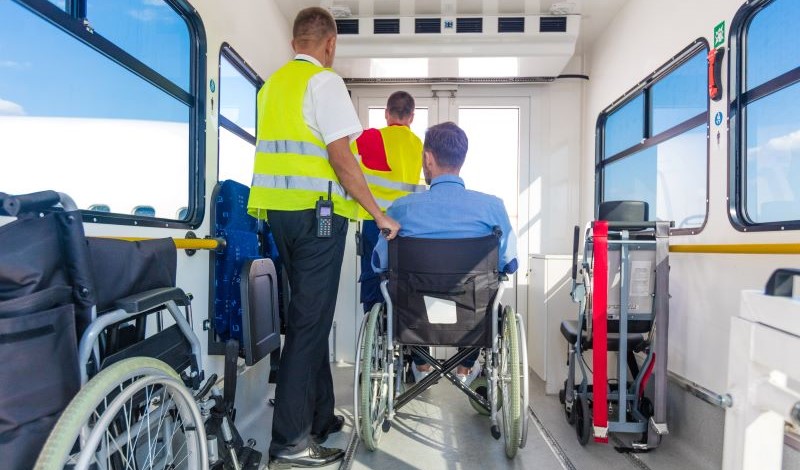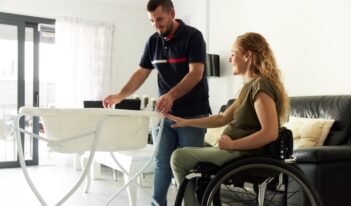
Current regulations limit accessibility of air travel to people with disabilities.
Almost sixty years ago, Professor Jacobus tenBroek famously argued that state regulation of disability ought to emphasize a “right to live in the world.” Today, law and policy give meaning to this right. But one underexamined aspect of the right to live in the world is the right to move in it.
“Mobility justice,” an umbrella term for an emerging interdisciplinary field of study that considers how power and inequality inform the regulation of movement, emphasizes what the right to move in the world looks like for different people. One of the field’s leading scholars, Mimi Sheller, describes the field’s wide-ranging emphasis on “embodied and material practices of movement” and “infrastructures and systems of governance that enable or disable movement.” She also emphasizes its focus on the “representations, ideologies, and meanings attached to both movement and stillness, connection and disconnection, and often the simultaneity of both.”
Air travel is one natural site to interrogate how mobility justice impacts disabled people. According to the Federal Aviation Administration (FAA), approximately 2.9 million airline passengers take more than 45,000 flights each day and move across 29 million square miles of airspace. No longer a luxury good, lower flight costs have democratized air travel, at least in theory.
In 2019, according to estimates by the U.S. Department of Transportation, approximately 27 million passengers with disabilities traveled by air.
Yet greater overall access masks the realities and stakes of air travel for people with disabilities. By failing to frame the harm correctly, the regulatory framework continues to fall short of its enforcement goals.
Consider the case of Engracia Figueroa.
Airlines require wheelchair users to check motorized wheelchairs and use an aisle chair to navigate onboard the aircraft. Passengers with mobility impairments receive assistance in boarding and deplaning from airline staff and independent contractors. In July 2021, Figueroa’s $30,000 customized and motorized wheelchair, which she used for mobility due to spinal cord injury and leg amputation, was damaged in flight. Initially, the airline refused to replace the chair, instead offering a manual wheelchair as a loaner while Figueroa’s chair underwent repairs.
Figueroa experienced health complications while she worked with the airline to resolve the dispute. Importantly, the use of a manual, non-customized chair limited her ability to leave her apartment and, by doing so, “re-disabled” her, as Figueroa described it. In addition, Figueroa developed pressure sores and subsequent infections leading to multiple emergency hospitalizations and surgery. Engracia Figueroa passed away in October 2021.
Figueroa’s story demonstrates the importance of assistive devices to the independence of many wheelchair users. Rather than a claim for lost or damaged luggage, Figueroa’s dispute concerned damage to what amounts to a bodily appendage that allows her freedom of movement, something not so easily replaced or gambled in air travel. Disabled travelers must decide whether and to what degree to assume certain disproportionate risks of air travel.
In 2021, the Paralyzed Veterans of America surveyed disabled air travelers to better understand their experiences. According to the survey, among the disabled travelers who fly, almost 84 percent fly at least twice a year and would likely fly more but for their concerns about accessibility and safety. Of those travelers who use a wheelchair or scooter, almost 70 percent reported damage to the device and 56 percent experienced delays.
Of those who avoid air travel, 73 percent noted that their decisions were motivated by concerns about potential damage to their wheelchairs. Among these same respondents, 62 percent avoided air travel due to concerns over their ability to use the aircraft’s restroom and 54 percent due to concerns about personal safety in transferring from their wheelchair to an aisle chair and onto an aircraft seat.
Furthermore, data collected by the U.S. Department of Transportation indicate a steady rise in disability-related complaints received by U.S. domestic carriers. Disability-related complaints increased from 27,556 in 2014 to 42,418 in 2019—a 54 percent increase. Although the aggregate number of these complaints may appear low compared to the overall number of travelers, the Transportation Department has investigated and fined carriers for failure to follow data reporting requirements, which only raises questions about the fidelity of what we know about the extent of disability discrimination under the Air Carrier Access Act of 1986 (ACAA).
The ACAA prohibits disability discrimination in air travel by domestic or foreign air carriers. Aggrieved persons can seek administrative remedies by filing a complaint directly with the airline carrier or the agency. The Transportation Department’s regulations require airline carriers to have a “Complaint Resolution Official” available to assist airline staff with dispute resolution onsite at airports.
The administrative dispute resolution process, however, does not offer individual complainants compensatory damages or a pathway to federal court. There is no private right of action in the context of the ACAA, at least according to a majority of circuit courts that have addressed the issue.
For example, the Fifth Circuit in Stokes v. Southwest Airlines explained that the ACAA does not reflect the degree of congressional specificity required to find a private right of action. Part of court’s reasoning in Stokes and related cases was that Congress set up a comprehensive administrative framework for enforcement that includes review of all complaints of disability discrimination against air carriers and the power to compel compliance with the ACAA.
Congress reauthorized the Federal Aviation Act in 2018 and instructed airlines and the Transportation Security Administration to address air travel problems through more training and attention to equipment and medical devices. The Transportation Department, for its part, published an Air Passengers with Disabilities Bill of Rights in July 2022, a plain language description of rights and remedies under the ACAA, including the rights to be treated with dignity and respect, to receive assistance at the airport and on the aircraft, and, remedially, to file a complaint for discrimination against air carriers and airports.
But even if air carriers implemented the Bill of Rights faithfully, would mobility justice become a reality? Deeper structural deficiencies exist that require sustained public engagement and discourse. Advancing meaningful access to air travel will require further attention to at least three important avenues for reform.
First, descriptions of the Transportation Department’s administrative scheme as “comprehensive” rely on conceptions of harm that treat assistive devices as fungible property rather than extensions of the disabled body. When we reframe the harms to reflect their true impacts, the remedial deficiencies of the system become clearer. Congress should revisit the dispute resolution process by creating a private right of action for aggrieved individuals under the ACAA, as proposed in the Air Carrier Access Amendments Act of 2021 (ACAAA) and its companion bill, H.R. 1696; in fact, lawmakers recently reintroduced the ACAAA in the House, and companion legislation is expected in the Senate in the coming weeks. A new private right of action should also include the possibility of compensatory and emotional distress damages to better capture the liberty and dignity interests at stake.
Second, regulators should mandate structural changes, including universal redesigns to make all aircraft more accessible. Rather than continue piecemeal accommodations premised on the idea of disability scarcity, design regulations should reflect the pervasiveness of disability in society and the fact that one in four adults identify as disabled. Current Transportation Department regulations, for example, require aircraft with more than one aisle to have at least one bathroom accessible to those who use assistive mobility devices. Airlines must ensure that any new aircraft complies with this requirement. But a truly structural approach would go further and create new baselines, intentionally phasing in universally designed aircraft that would make every restroom onboard accessible and include other accessibility features, such as movable armrests. That way, over time, accessible design will become the new norm.
Finally, attention to data collection and dissemination will bring greater transparency and accountability to the Transportation Department’s current enforcement. Although the ACAA already requires the Transportation Department to report data on disability discrimination, the current complaint form does not request demographic information. Demographic data may be important in thinking about the existence and operation of intersectional discrimination, such as on the basis of disability and race or gender. The aesthetics of disability affect the perception and treatment of disability in public spaces such as airports. A broader pool of data can offer the ability to study patterns of discrimination and create opportunities to address a more complete accounting of the harms experienced by people with disabilities in air travel.
In sum, in this next generation of civil rights discourse, the “right to live in the world” espoused by disability rights law and policy ought to be modified to reflect more fully the need for meaningful access and mobility justice. The right to move in the world perhaps better encapsulates one vital contour of such a right to live.
This essay is part of a four-part series entitled, Mobility Justice.




